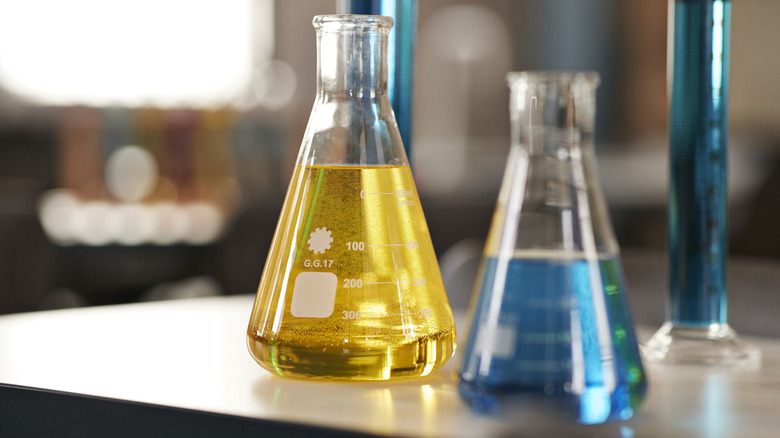How To Neutralize Muriatic Acid
Muriatic acid is a common name for hydrochloric acid, a highly corrosive chemical substance. This compound has numerous industrial and domestic uses, ranging from food, metals, and polymer processing to swimming pool water disinfection. Even in dilute form, muriatic acid can irritate the eyes and skin and cause respiratory problems. In concentrated amounts, it can cause severe chemical burns and even death. You must neutralize any spillage by mixing it with a mild base before you clean up the spill.
Chemical reactions
Neutralization of an acid occurs when it is combined with a base to produce a salt and water. Muriatic acid consists of positively charged hydrogen ions and negatively charged chlorine ions. A basic liquid such as caustic soda (sodium hydroxide) consists of positively charged sodium ions and negatively charged hydroxyl ions. During the reaction, the hydrogen and hydroxyl ions combine to form water while the chlorine and sodium ions combine to produce sodium chloride, known as table salt. Weaker basic substances such as baking soda (sodium bicarbonate), soda ash (sodium carbonate), and lime (calcium carbonate) break down into positive sodium or calcium ions and negative carbonate ions in the acid. Hydrogen and carbonate ions combine to produce carbon dioxide gas in a fizzing effect together with water. The metal and chloride ions combine to produce sodium or calcium chloride salt.
Heat from chemical reactions
Acid neutralization is a highly exothermic reaction, meaning that it produces large amounts of heat that can vaporize any water produced. Any carbon dioxide that is produced in a small neutralization reaction can irritate your eyes and throat, although it will not be in large enough volumes to be lethal. To minimize heat and carbon dioxide, add the base material slowly and gradually to the muriatic acid.
Protective clothing
Eye and skin protection should be worn with acid-compatible gloves — such as those made of neoprene or nitrile — as latex gloves dissolve in acid. Any source of flame or ignition should be switched off.
Small spills
Baking soda, soda ash, and lime are the safest and most economic methods of neutralizing small or domestic spills of muriatic acid. Sprinkle the neutralizer slowly around the edges of the spill and then toward the center to minimize any carbon dioxide foaming. Once you have neutralized the spill, cover it with dry sand, soil, or another inert material — such as vermiculite — and place it in a special container for chemical waste, then dispose of it.
Large spills
Limestone and dolomite (calcium magnesium carbonate) are common neutralizing agents for large-scale muriatic and other acid spills in natural water courses and coal mine water flows. Both materials react with the acid over a period of about 15 minutes to produce salts in a sludge that can be easily handled and removed. Limestone is the superior reactant of the two.
